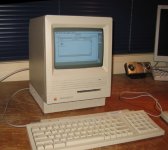tezza
Veteran Member
I’ve been having fun(?) with baby Macs this weekend.
First I was given a Mac SE on Friday. Case is in good condition but the screen was initially just vertical wavy lines and (after a few on/offs) it didn’t go at all. I pulled it apart and resoldered connections as advised in a few diagnostic guides off the Internet but to no avail. I’ve put it to one side for now. I’m not sure if I can be bothered to replace the suspected faulty caps or diodes just at this point in time. It’s hard to work on as it’s so grimy inside! Is this typical of Macs? It is fairly vintage, so I may have a go later on when I feel more motivated. Or I might just sell it as a broken unit.
Are SE’s significant from an historical or collectable point of view?
Second, I did some work on my other Mac, the Classic II. This is an ex-school machine with a copy of “At Ease”, a security program to stop little hackers dabbling with the System. This is fine, except when the admin password had been lost, in which case it is a pain in the arse because you can't actually DO anything!
Anyway, I had what I thought was a good 2-disk copy of System 7.1 so I reformatted the hard drive and re-installed the DOS. Problem was, the 2nd disk turned out to be faulty, giving me an unknown error -#192 before completing the install. I found I could only install a minimal version of the DOS, not the full one (grrr).
I found a copy of 7.1 on the Internet in .sea.hqx format. Anyone know how I can turn this into 1.4MB Mac install floppies from a PC? I’m picking it won’t be easy.
I also tried to install Lemmings on this machine. I had the disk but the installation insists you find pieces of info in the Lemmings Manual to install properly. I had no manual of course. Anyone know where I might find a Mac-version manual on the Web (I have looked but no luck).? Alternatively, a cracked Mac version where no such manual info is required?
Hmm..when I look back on what I’ve written, not a terribly successful weekend vintage-computer wise.
The baby Macs are kinda cute though!
First I was given a Mac SE on Friday. Case is in good condition but the screen was initially just vertical wavy lines and (after a few on/offs) it didn’t go at all. I pulled it apart and resoldered connections as advised in a few diagnostic guides off the Internet but to no avail. I’ve put it to one side for now. I’m not sure if I can be bothered to replace the suspected faulty caps or diodes just at this point in time. It’s hard to work on as it’s so grimy inside! Is this typical of Macs? It is fairly vintage, so I may have a go later on when I feel more motivated. Or I might just sell it as a broken unit.
Are SE’s significant from an historical or collectable point of view?
Second, I did some work on my other Mac, the Classic II. This is an ex-school machine with a copy of “At Ease”, a security program to stop little hackers dabbling with the System. This is fine, except when the admin password had been lost, in which case it is a pain in the arse because you can't actually DO anything!
Anyway, I had what I thought was a good 2-disk copy of System 7.1 so I reformatted the hard drive and re-installed the DOS. Problem was, the 2nd disk turned out to be faulty, giving me an unknown error -#192 before completing the install. I found I could only install a minimal version of the DOS, not the full one (grrr).
I found a copy of 7.1 on the Internet in .sea.hqx format. Anyone know how I can turn this into 1.4MB Mac install floppies from a PC? I’m picking it won’t be easy.
I also tried to install Lemmings on this machine. I had the disk but the installation insists you find pieces of info in the Lemmings Manual to install properly. I had no manual of course. Anyone know where I might find a Mac-version manual on the Web (I have looked but no luck).? Alternatively, a cracked Mac version where no such manual info is required?
Hmm..when I look back on what I’ve written, not a terribly successful weekend vintage-computer wise.
The baby Macs are kinda cute though!

